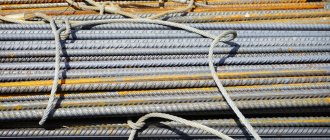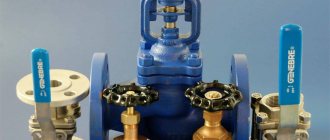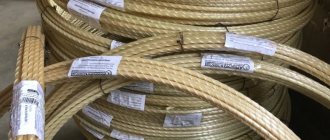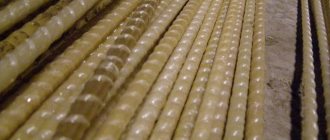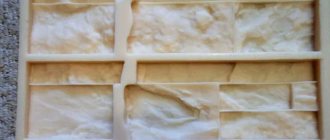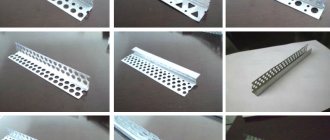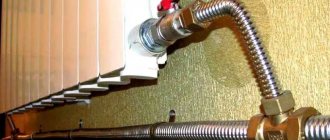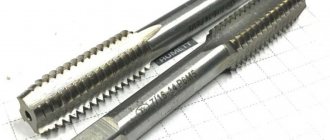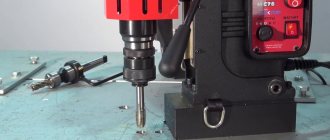Strict competition requirements in the field of modern construction force us to look for ways to reduce costs, including the use of new materials. New formulations of building stone, special grades of concrete, foundation compositions, facing and thermal insulation materials are appearing. At the same time, in a market previously traditional for metal reinforcement and special structures, manufacturers of various composite products are actively trying to win their “place in the sun.” Most often these are non-metallic strength elements and fiberglass reinforcement.
Types of plastic fittings
There are several types of reinforcement, depending on what material it is made from:
- Fiberglass. It began to be used back in the days of the Soviet Union. At that time, there was a rapid development of printed circuit editing in the field of radio electronics. The boards were then made from PCB. The peculiarity of this material is its woven base, bonded with artificial resin. Gradually fiberglass replaced fabric. Thanks to this, it was possible to expand the scope of application of fiberglass. They began to make furniture and household goods from it. The material has even found its place in aircraft manufacturing and the military industry. Over time, it was introduced into construction. Frames for the foundation began to be made from fiberglass reinforcement. They are suitable for conditions where other materials would deteriorate quickly. To create fiberglass, glass and epoxy resin are used.
- Basalt-plastic. This material is easier to make than fiberglass. Only basalt is enough for it. The popularity of such reinforcement is associated with its high level of strength and elasticity. It conducts less heat, but is heavier.
- Carbon fiber. This is an expensive material that requires carbon fiber and resins. The high price is due to the peculiarities of carbon fiber production. It forms the basis of the material. To obtain it, all temperature parameters and processing time must be strictly observed, since organic fibers are used as raw materials. The use of this material is possible in different areas of life. This plastic foundation reinforcement is very elastic, but the downside is its fragility. Therefore, if you plan to build a more durable and stressed structure, choose another option.
The first option is the most popular, since its price is not high and its performance properties are quite acceptable.
Opinions about plastic reinforcement as a building material
There is debate about the ideality of plastic reinforcement as a material for construction. Builders consider the low strength of the foundation to be a big disadvantage when applying lateral pressure to the structure.
Important! Also, a big disadvantage, according to experts, is the regulatory documentation, which is missing for this building material.
People are also put off by the lack of any instructions on how to properly knit plastic reinforcement, since when it comes to practice, many do not understand how to deal with such a light and unmanageable material.
As builders note, plastic reinforcement is more suitable for foundations, while it cannot be used in the construction of interfloor ceilings. At the same time, fiberglass is chosen because it is cheaper and does not corrode.
How to produce
Composite rods are made in three ways:
- Needletrusion. During the procedure, individual fibers are twisted into one and at the same time impregnated and braided. Since such technological lines operate at high speed, the process does not require large financial costs, which also affects the price. In order for the reinforcement to acquire a characteristic relief, it is wrapped with threads and a periodic profile. The thickness of the rods depends on the number of threads. This manufacturing method allows us to obtain products that have good adhesion to concrete.
- Plaintrusion. First, the main rod is formed, after which it is wrapped in a spiral in two directions.
- Pultrusion. This is the oldest technique. First, the fiber is formed and impregnated, and when it hardens, it is pulled through a spinneret. This system operates at the polymerization temperature of the plastic and allows the final forming and stretching of the reinforcement. The cost of the material obtained by this method is higher, and the production speed is low.
There are smooth or profiled products.
Specifications
The production of glass fittings takes place in accordance with GOST 31938-2012. The document specifies what size the products should be, their appearance, raw materials, environmental safety and other parameters.
A plastic frame, like a metal one, is used to fasten the monolith in order to increase its ability to withstand loads. This allows you to increase the service life of the building.
The functions of such reinforcement do not differ from steel, and it has the same indicators:
- The weight of the products is 0.02-0.42 kg per meter.
- The length according to the state standard should be 0.5-12 m. The parameter is measured in 0.5m increments.
Finished plastic reinforcement for the foundation must not have chips, cavities, burrs, wounds with gusts, delamination, or dents.
When reinforcing the foundation, steel rods are gradually beginning to be used more. To ensure better adhesion to concrete, they are additionally treated with sand.
Features of plastic fittings
In the manufacture of plastic reinforcement, threads made of glass, basalt or carbon fiber are used, connected into a common cable using a composite composition.
Important! The finished reinforcement is a rod with a round cross-section, the surface of which can be either smooth or ribbed.
The ribbing is created by enveloping the rod with glass fibers. Such reinforcement is more in demand when working with concrete, as it provides strong adhesion to the mortar.
Fiberglass reinforcement
As for the diameter, everything happens here by analogy with its steel competitor, and this is not the only comparison between the two types of reinforcement .
The weight of such a reinforcing bar is more than five times lower than that of a metal one. The foundation for a house made using fiberglass reinforcement is quite light, thereby reducing the load on the ground.
And with any reduction in load, the cost of the foundation and the work on pouring it also decreases, that is, there are also financial aspects.
Advantages and disadvantages
Plastic reinforcement has gained popularity in construction due to a large number of positive properties:
- The rods have increased strength. Even when exposed to tensile forces, the material can retain its properties.
- The price is affordable. A foundation made of plastic reinforcement will cost less than if you use metal rods.
- Small mass. This facilitates the work process and transportation of products.
- Reliability. There is no need to treat the material with protective coatings. It is not subject to corrosion and easily tolerates sea water, hydrochloric acid, and alkalis.
- Low level of thermal conductivity. The rods can be used for residential buildings, as they do not create cold dams. This allows you to create favorable temperature conditions in the room.
- Safety for the environment. During the production of products, sanitary standards are strictly observed, so they do not pose a danger to human life and the environment.
- Long service life. Reviews show that with the help of plastic reinforcement it is possible to improve the performance properties of the structure several times.
- Easy to cut and convenient to deliver to the job site. To obtain the required length of the workpiece, you do not need to use special tools.
- Can be installed without the use of welding equipment. Products are knitted with wire or special fasteners.
- They retain their properties even at temperatures of -70 degrees.
- They have dielectric properties. Thanks to this, the products are not destroyed under the influence of stray currents and have increased safety.
Experienced builders claim that plastic reinforcement is ideal for foundations.
The material also has negative reviews associated with some shortcomings of the filler. Such fittings have the following disadvantages:
- Low heat resistance. Polymer binders can withstand a limited temperature range, so plastic rods cannot be used everywhere.
- If they are heated to 200 degrees, the strength decreases and the flammability increases.
- Lower elastic modulus. When using composite rods, it is necessary to carry out special calculations to confirm the possibility of using this material for a load-bearing structure.
- If the reinforcement is constantly in an alkaline environment, then its strength characteristics will gradually deteriorate.
- Hard to bend. This material is difficult to obtain a radius shape. To achieve this you will have to resort to special technological techniques.
Reviews from builders about plastic reinforcement for foundations are quite high. Experts say that such rods:
- They have increased elasticity.
- Not subject to deformation.
- They do not require large financial outlays.
- Do not corrode.
- They do not respond to electromagnetic fields.
- No shielding.
Due to its positive performance properties, the composite is used in many fields. It is a serious competitor to steel.
Using fiberglass rods in the foundation
The use of reinforcing mesh based on fiberglass load-bearing elements began in the 60s of the last century. In addition, a fairly large number of buildings and technological structures made of stone and concrete have been built and are in operation, in the foundations and walls of which fiberglass-based reinforcement is used. Feedback on the condition of buildings with elements of steel and fiberglass reinforcement and many years of operating experience will give more than all the theoretical calculations of “experts” combined.
Almost everyone who makes videos or posts their opinion about the shortcomings of fiberglass reinforcement is either sales managers of competing steel products, or amateurs who confuse the causes and consequences of the basic principles of strength and rigidity of structures. For the most part, such discussions about the disadvantages of fiberglass reinforcement are accompanied by formulas and data on the strength of steel and composites. But there are no clear reasons or processes why fiberglass reinforcement cannot be used. If a person who undertakes to comment on the advantages and disadvantages of fiberglass reinforcement has not demonstrated in practice a fragment of destroyed concrete or a piece of foundation with fiberglass reinforcement, all his reasoning remains fantasies on an arbitrary topic.
Fiberglass reinforcement has been used in construction, mechanical engineering, and special projects for more than 40 years. If this issue is of fundamental importance to you, refer to old Soviet textbooks from the 70s of the last century, magazines on construction topics; these sources reveal the physics and mechanics of foundation destruction processes and provide numerous examples of errors.
Possessing high specific strength, fiberglass reinforcement can work perfectly in the most difficult conditions, but at the same time it has a number of disadvantages that limit its use in construction:
- The fiberglass nature of composite reinforcement has almost zero ductility of the material. In human terms, a frame for a highly loaded foundation or walls made of such a rod will not be able to plastically adapt to the redistribution of load in a loaded concrete stone. As a result, in some places the building’s foundation will experience overload, which can cause cracks to appear;
- The fiberglass base takes tensile axial loads very well, but compressive loads much worse, and tolerates shear forces catastrophically poorly. This means that any transverse shearing force, of which there are many in “fresh” foundations due to sedimentary processes, will lead to destruction of the integrity of the reinforcement;
- Unfortunately, during the time that the concrete of the foundation gains strength, the fiberglass frame behaves somewhat differently, and precisely at this stage, therefore, each specific case in the arrangement of reinforcement requires a very careful and careful analysis.
Therefore, in those units where it is permissible to replace metal with a composite material, instead of a traditional eight-millimeter rod, a six-millimeter fiberglass reinforcement strand can be used. Few people know, but today building slabs from stressed concrete with fiberglass reinforcement are already being produced. But in production such material is much more expensive, so almost 90% of the range, including for foundations, are custom-made products.
Application in construction
Plastic reinforcement is used in the same way as steel. With their help they build:
- bridges;
- walls and floors;
- different types of foundations;
- fencing.
The composite is used in the production of sleepers, since concrete disintegrates under intense vibration. With its help, docks, berths, and various coastal barriers are erected. I equip shafts with such fittings and secure insulation and cladding materials.
It is not uncommon for polymer rods to replace steel parts during the construction of a frame or wooden building.
Working with different types of plastic fittings is much easier and more convenient. The process does not require large financial expenditures when compared with metal structures.
There is practically no similar material in the world. Its positive qualities allow it to expand its scope of application. It meets all the requirements of the construction process.
The linear expansion of concrete when using plastic and steel reinforcement occurs in the same way. Thanks to this, there is no risk of cracks and other deformations while pouring the solution.
Fiberglass reinforcement for foundations: reviews
Content
Fiberglass reinforcement for foundations, mysticism or reality? Strict competition requirements in the construction industry force us to look for ways to reduce costs. And including using new materials. New formulations of building stone, special grades of concrete, foundation compositions, facing and thermal insulation materials are appearing. In parallel, in a market previously traditional for metal fittings and special structures. Manufacturers of various composite products began to become more active. Most often these are non-metallic strength elements and glass and plastic fittings.
Why did fiberglass reinforcement appear on the construction market?
Composite materials, including glass and plastic fittings, are manufactured using a relatively simple technological principle. Impregnation of glass or basalt fibers with epoxy or polyester matrix resin. Next, the beam is formed on a machine into a rod of composite reinforcement calibrated in diameter. And it is baked at low temperature in a special drying oven. Typically, the length of one piece of reinforcement does not exceed 100 m.
Fiberglass reinforcement does not require complex and expensive equipment. Therefore, the production costs themselves are relatively low. Most of the cost is the price of the resin for the matrix and the glass fiber tow. And yet, if you compare the cost of glass plastic and steel rods of the same diameter. Then metal fittings have a warehouse price of 10-20% less, and this is a very big difference for such an area as construction.
Nevertheless, fiberglass material has quite strongly displaced rolled metal products. And not least because of a number of specific properties, but the main factors were slightly different reasons:
Properties of fiberglass reinforcement
- Fiberglass reinforcement has increasingly begun to be used in private low-rise construction. It is more accessible to use, it is easier and much cheaper to transport, store, and cut. It does not need to be straightened and leveled before use, as is the case with the steel version. The material can be bought in a whole bay and cut into pieces of the most non-standard length. Whereas a standard 11-meter steel rod would require a lot of waste;
- The availability of equipment for the production of reinforcing strands has made it possible for many small enterprises. That is, manufacturers of building materials should establish in-line production of fiberglass reinforcement. In a wide variety of bar surface designs. A huge number of offers, a competent sales policy and hidden advertising allow you to diversify the market;
- The desire of contractors to save money in construction work by using more cost-effective reinforcement materials. For this purpose, a formal recalculation of the equivalent strength of composite materials and steel reinforcement is often used.
Reviews from experts, advantages and disadvantages of composite thread
If you wish, you can find the most complex calculations and fairly simple primitive arguments. About why glass and plastic fittings are good or bad. As a rule, serious research and expert reviews in most cases do not provide specific recommendations. In fact, foundation problems and, in many ways, the capabilities of fiberglass-based reinforcement must be assessed at your own peril and risk.
Among numerous reviews from specialists. There are practically no real professional experts in the field of structural mechanics of composite materials. Their opinions and feedback are usually reflected in estimates and custom calculations for specific construction projects. Which cost a lot of money and are not presented to the public.
An approach can be called professional if the reviews of certain experts evaluate a specific situation of use. For example, glass of plastic rod in the foundation of a house using practical results and analysis of the reasons. Otherwise, such expert reviews can be called, at best, advertising or anti-advertising.
Using fiberglass rods in the foundation
The use of reinforcing mesh based on glass-plastic strength elements began in the 60s of the last century. In addition, a fairly large number of buildings and technological structures made of stone and concrete have been built and are in operation. Glass-plastic reinforcement is used in the foundation and walls. Reviews about the condition of buildings with elements of steel and fiberglass reinforcement and many years of operating experience. They will provide more information than all the theoretical calculations of the “experts” combined.
Almost everyone who films videos or shares their opinion about the disadvantages of fiberglass reinforcement. These are either sales managers of competing steel products. Or amateurs who confuse the causes and consequences of the basic principles of strength and rigidity of structures. For the most part, such discussions are about the disadvantages of fiberglass reinforcement. Accompanied by formulas and data on the strength of steel and composite. But there are no clear reasons or processes why fiberglass reinforcement cannot be used. If a person undertakes to comment on the advantages and disadvantages of fiberglass reinforcement. But at the same time, he did not demonstrate in practice a fragment of destroyed concrete or a piece of foundation with fiberglass reinforcement. Then all his reasoning remains fantasies on an arbitrary topic.
A little history
Reinforcement has been used in construction, mechanical engineering, and special projects for more than 40 years. If this issue is of fundamental importance to you, refer to old Soviet textbooks from the 70s of the last century. Magazines on construction topics, these sources reveal the physics and mechanics of foundation destruction processes. And numerous examples of errors in foundation manufacturing are given.
Possessing high specific strength, the reinforcement can work perfectly in the most difficult conditions. But at the same time, it has a number of disadvantages that limit its use in construction:
- The nature of composite reinforcement has almost zero ductility of the material. In human terms, a frame for a highly loaded foundation or walls made of such a rod. It will not be able to adapt plastically to the redistribution of load in a loaded concrete stone. As a result, in some places the building’s foundation will experience overload, which can cause cracks to appear;
- The fiberglass base takes tensile axial loads very well. Much worse compressive loads, and catastrophically poorly tolerates shear forces. This means that any transverse shear force. And of which there are many in “fresh” foundations due to sedimentary processes, will lead to the destruction of the integrity of the reinforcement;
- Unfortunately, while the foundation concrete gains strength, the fiberglass frame behaves somewhat differently. Namely, at this stage, therefore, each specific case in the arrangement of reinforcement requires a very careful analysis.
Therefore, in those units where it is permissible to replace metal with a composite material. Then, instead of the traditional eight-millimeter rod, a six-millimeter reinforcement harness can be used. Few people know, but today building slabs from stressed concrete with glass-plastic reinforcement are already being produced. But in production such material is much more expensive. And therefore, almost 90% of the assortment, including for the foundation, are custom-made products.
Application options for glass reinforcement
An undeniable advantage of steel reinforcement is the very well predictable behavior of the metal under the most difficult loading conditions. All existing skyscrapers and high-rise buildings are built only on steel reinforcement. Moreover, most of these wonders of the world have an internal metal frame.
Glass reinforcement is not suitable for high-rise buildings or highly loaded foundations. The structural mechanics of foundations is, in general, a whole science. First of all, due to the complex interaction of individual parts of the foundation with the soil, with the walls of the entire structure.
In the existing foundation model, the most problematic areas are the corner zones. Where the reinforcement experiences tensile, bending and tying loads. In these places, not every steel reinforcement is able to provide a rigid connection of corner blocks. The metal reinforcement in the foundation block achieves this only due to a combination of high ductility and elasticity. Fiberglass reinforcement cannot be used in these foundation units. Despite its high longitudinal strength, it will not be able to withstand torsion at the corner contact point of the foundation.
Low-rise housing construction
The strength and ductility of glass-plastic reinforcement will be sufficient to build the foundation and basement of a one or two-story house. But provided that in the corner joints of the foundation, special couplings will be used to splice the reinforcement at right angles. Moreover, fiberglass is easy and simple to use for a simple strip foundation 70-90 cm deep.
The use of reinforcement in combination with special grades of concrete for the foundation is considered successful. Often when special additives are used in the foundation. Increasing frost resistance or water resistance, steel reinforcement begins to corrode intensively. Especially in foundations on soils with a high salt content or in close proximity to transformer substations.
In the walls of low-rise buildings, especially those made of aerated concrete blocks, arbolite stones and any other building materials. Having low rigidity and contact strength, the use of glass-plastic reinforcement is even encouraged. It is much simpler and easier to work with than a steel bar.
In addition, composite reinforcement is simply ideal for attaching external insulation or laying facing bricks. Where either galvanization or stainless steel is required. And, even more so, it is worth using a thin glass thread for working on the base blocks of the foundation.
Let's sum it up
Another problem characteristic of Russian reality, which is definitely worth mentioning. This is the low quality of the fiberglass reinforcement of the domestic manufacturer. Almost every coil with reinforcement has fracture defects.
During storage and transportation, a metal rod can be unloaded in an inconvenient place far from the foundation. But in any case, its quality will not suffer. Glass and plastic thread can be easily damaged during transportation and not even notice it. It is definitely impossible to lay such reinforcement in the foundation.
Columnar slab foundation device
How to make concrete for a foundation
Foundation waterproofing
Knitting features
You need to find out how to knit plastic reinforcement for the foundation in order to carry out the procedure correctly. A high-quality and reliable foundation is the guarantee that the house will last a long time. Therefore, reinforcement of the base is an important stage of construction.
Most often, strip foundations are used for buildings. For this purpose, the knitting of plastic reinforcement is carried out with some special features. This procedure helps to make the structure uniform and durable. The rods are tied at their intersections. This is done with wire or special means.
The wire is bent in the middle, after which it is put on a hook, applied to the reinforcement and tightened. This is quite difficult, so a plastic tie will help make the job easier.
Plastic shut-off valves are considered an important element of the reinforcing system. It helps to more firmly attach individual rods to each other.
Fasteners are popular among builders. These are embedded parts that create a protective layer of a certain thickness in concrete.
Such clamps are made of polyethylene. They are poured under high pressure. They provide reliable fastening of reinforcing bars, frames and allow you to obtain a strong concrete or reinforced concrete structure. Clamps are used in horizontal and vertical surfaces, and they are also used to create formwork.
Laying plastic reinforcement for the foundation
Reinforcement clamps
The first step is to assemble the frame provided for by the project. Rods with a diameter of 8 mm are laid out in a longitudinal position, with a diameter of 6 mm in a transverse position, and a base is formed, which is laid in the formwork and filled with concrete mortar.
Plastic rods are connected to each other using wire or special clamps. When forming a foundation, it is advisable to choose plastic reinforcement with a ribbed surface so that the adhesion to concrete is high-quality and durable.
Tips for choosing
Nowadays the number of manufacturers of composite reinforcement has increased, so low-quality products are found. Therefore, when choosing a material, you need to pay attention to the following nuances:
- Color. If the rods are good, then in the entire batch they are the same color. If some elements have a different color, then there was a temperature violation during production.
- Cracks and delaminations. They shouldn't exist. These defects are easy to notice on the cut.
- Fiber breaks. Because of them, the characteristics of the material are reduced. They are visible to the naked eye.
- Uneven winding. This indicates the use of old equipment and a loss of continuity.
Over time, they plan to introduce strict requirements for plastic fittings. This material can replace steel. But in order not to end up with a low-quality product, you should carefully study the characteristics.
Steel or fiberglass (basalt, composite, etc.) reinforcement?
The question often arises about what kind of fittings to use. Despite the desire of sellers to advertise fiberglass reinforcement, professional builders use it with caution. Right now, on my way to work, I pass the construction of the Kashirskoe Highway and MKAD interchange. I observe monolithic works. And not a single fiberglass rod is visible there. Exclusively steel and at least the reinforcement cages of the bridge supports are rigidly welded.
Here is the main disadvantage of fiberglass reinforcement and its sellers, if mentioned at all, do so in passing: “Fiberglass reinforcement bends very easily, that is, it has a low modulus of elasticity. This, in turn, significantly narrows the scope of application of the material: foundations, road slabs, etc. But as for floors, special conditions are required and the involvement of specialists is required to carry out the necessary calculations.” —
That is, they say, well, there is such a moment, well, yes, but this is just one drawback. However, this is the main drawback that negates all the advantages. The modulus of elasticity is 4 times less, which means that on structures where deflection is critical (floor slabs, crossbars, balconies, spans, etc.) you need to take reinforcement 4 times thicker (section), and not 2 times thinner as advertised. The same can be said about walls and columns (elements standing vertically). That is, if 10 mm steel reinforcement is recommended in the floor slab, then it is necessary to replace it with 20 mm fiberglass (4 times the cross-section), and not 8 mm as recommended by builders. People advanced in mathematics can delve into further details from the strength of materials.
My vision after all this is this: where deflection is critical, there is no need for fiberglass reinforcement. Where deflection is not critical, but the gap is important, fiberglass can be considered. By the way, Americans use it in the construction of roads (where the canvas lies on a cushion), but not bridges.
The main question that I want to discuss is in what cases it is possible and in what cases it is definitely impossible to use fiberglass reinforcement.
Where not allowed: floor slabs, crossbars, bridges, supports, columns.
Where possible and desirable: monolithic slabs (roads, driveways) lying on the ground, provided that the cushion is made correctly. Septic tanks, underground, underwater, coastal concrete products (except bridges), especially in aggressive environments, such as septic tanks, where it is more important that there is no corrosion.
In the walls of a monolithic house, I am inclined to the possible use of fiberglass reinforcement in combination with steel (at the corners and openings it is steel, for the most part the walls are fiberglass).
Not sure about the piles, but probably not.
Does anyone have any other reasoned opinion on this topic?
